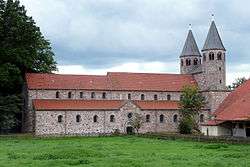Bursfelde Abbey
|
Bursfelde Abbey in 2010 showing the church | |
| Monastery information | |
|---|---|
| Order | Benedictine |
| Established | 1093 |
| Disestablished | 1579 |
| Mother house | Corvey Abbey |
| People | |
| Founder(s) | Heinrich of Northeim |
| Site | |
| Location | Bursfelde, Lower Saxony, Germany |
| Visible remains | only the church, new towers were built in the 19th century |
| Public access | yes |
Bursfelde Abbey (in German Kloster Bursfelde) was a house of the Benedictine Order located in the present Bursfelde, part of the town of Hannoversch Münden in Lower Saxony in Germany.
History
It was founded in 1093 by Count Heinrich the Fat of Northeim and first settled by monks from Corvey Abbey. In 1102 the founder, who had been killed by invading Frisians, was buried in the abbey church.
Emperor Henry IV granted it numerous privileges and immunities. Following the Benedictine tradition, Almeric, the first abbot, opened a school, which soon became famous, and under the next four abbots its fame continued to increase.
But in 1331, under abbot Henry Lasar, monastic discipline began to relax, the school was neglected and the valuable possessions dissipated. From 1331 to 1424 no records of the abbey were kept. When in 1424 the aged Albert of Bodenstein became abbot, both church and school had fallen almost into ruins, and the monastery itself was in a dilapidated condition, housing a single old monk. Albert was too old to undertake the gigantic task of restoring Bursfelde and resigned the abbacy in 1430.
During the 15th century a strong current of monastic and ecclesiastical reform made itself felt throughout the Roman Catholic world. One of the first Benedictine reformers was John Dederoth of Northeim. After carrying out notable reforms at Clus Abbey, where he had been abbot since 1430, Dederoth was persuaded by Duke Otto of Brunswick in 1433 to undertake the reform of Bursfelde. Obtaining four exemplary religious from the monastery of St. Matthias' Abbey, Trier, he assigned two of them to the monastery at Clus, to maintain his reformed discipline there, while the other two accompanied him to Bursfelde. As abbot of Clus, he was able to recruit from that community for Bursfelde. Dederoth succeeded beyond expectations in the restoration of Bursfelde and began the reform of Reinhausen Abbey, near Göttingen, but died on 6 February 1439, before his efforts in that quarter had borne fruit.
Bursfelde Congregation
- See main article Bursfelde Congregation
Dederoth's successor, John of Hagen, obtained permission in 1445 from the Council of Basle to restore the Divine Office to the original form of the old Benedictine breviary and to introduce liturgical and disciplinary uniformity in the monasteries that followed the reform of Bursfelde. On 11 March 1446 the Cardinal Legate Louis d'Allemand approved the Bursfelde Union or Congregation, which then consisted of six abbeys: Bursfelde itself, Clus, Reinhausen, Cismar in Schleswig-Holstein, St. Jacob near Mainz, and Huysburg near Magdeburg. On 6 March 1458, Pope Pius II approved the statutes of the congregation.
The Bursfelde Congregation was a highly beneficial reforming influence on the spiritual life of the time in the Benedictine monasteries of Germany during the second half of the fifteenth, and the first half of the sixteenth, century. At the death of Abbot John of Hagen thirty-six monasteries had already joined the Bursfelde Congregation, and just before the Reformation, at least 136 abbeys, scattered through all parts of Germany, belonged to it. The efficacy of the Congregation was severely curtailed by the Reformation, during which many of its member houses were dissolved, but continued in a restricted form until the secularisations of the late 18th and early 19th centuries dissolved the surviving religious houses.
Reformation and dissolution
In 1579, Andrew Lüderitz, the last abbot of Bursfelde, was driven out by the Lutheran Duke Julius of Brunswick, and Bursfelde ceased to be a Catholic monastery. The possessions of the abbey were confiscated, and the abbot was replaced by a Lutheran. A Protestant convent was accommodated here until well into the 17th century, when the estates were leased out to tenants. A few Catholic monks returned for a time during the Thirty Years' War.
The title of (Protestant) abbot has been bestowed since 1828 on the Senior Fellow of the Theological Faculty at the University of Göttingen.
The surviving abbey buildings are still used for theological training and conferences.The legal basis for the meeting house is the Evangelical Lutheran. Church of Hanover. The spiritual center is incorporated into the House of church Offices of the Church of Hanover. It is owned by the Hanover Chamber monaste.
References
- Heutger, Nicolaus, 1975. Bursfelde und seine Reformklöster, 2nd expanded edn. Hildesheim: August Lax.
-
 This article incorporates text from a publication now in the public domain: Herbermann, Charles, ed. (1913). "article name needed". Catholic Encyclopedia. New York: Robert Appleton.
This article incorporates text from a publication now in the public domain: Herbermann, Charles, ed. (1913). "article name needed". Catholic Encyclopedia. New York: Robert Appleton. - "Kloster Bursfelde". University Göttingen.
External links
| Wikimedia Commons has media related to Kloster Bursfelde. |
- Freckmann, Anja (2006). Die Bibliothek des Klosters Bursfelde im Spätmittelalter. ISBN 978-3-89971-271-1.
Coordinates: 51°32′30″N 9°37′29″E / 51.54167°N 9.62472°E
